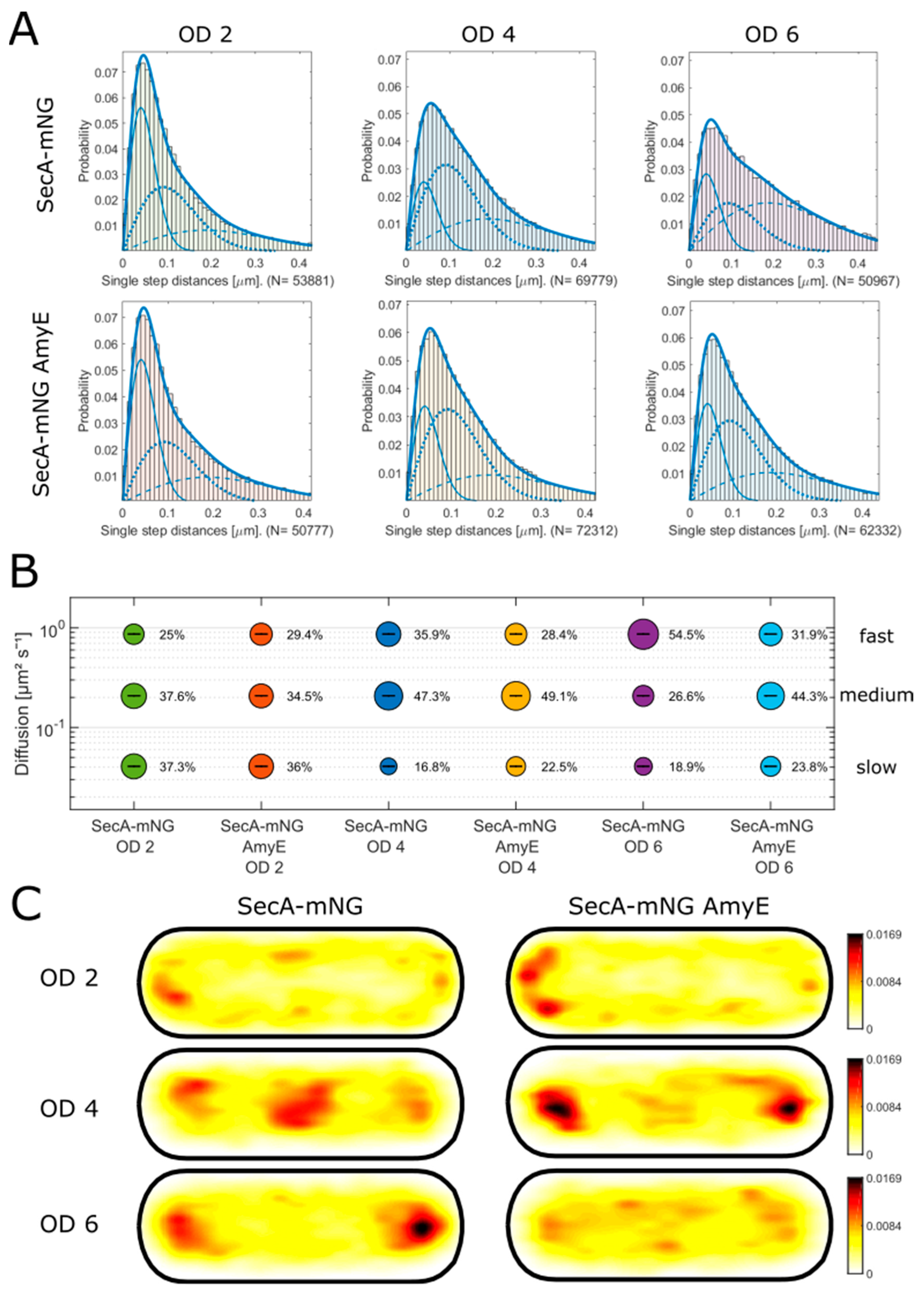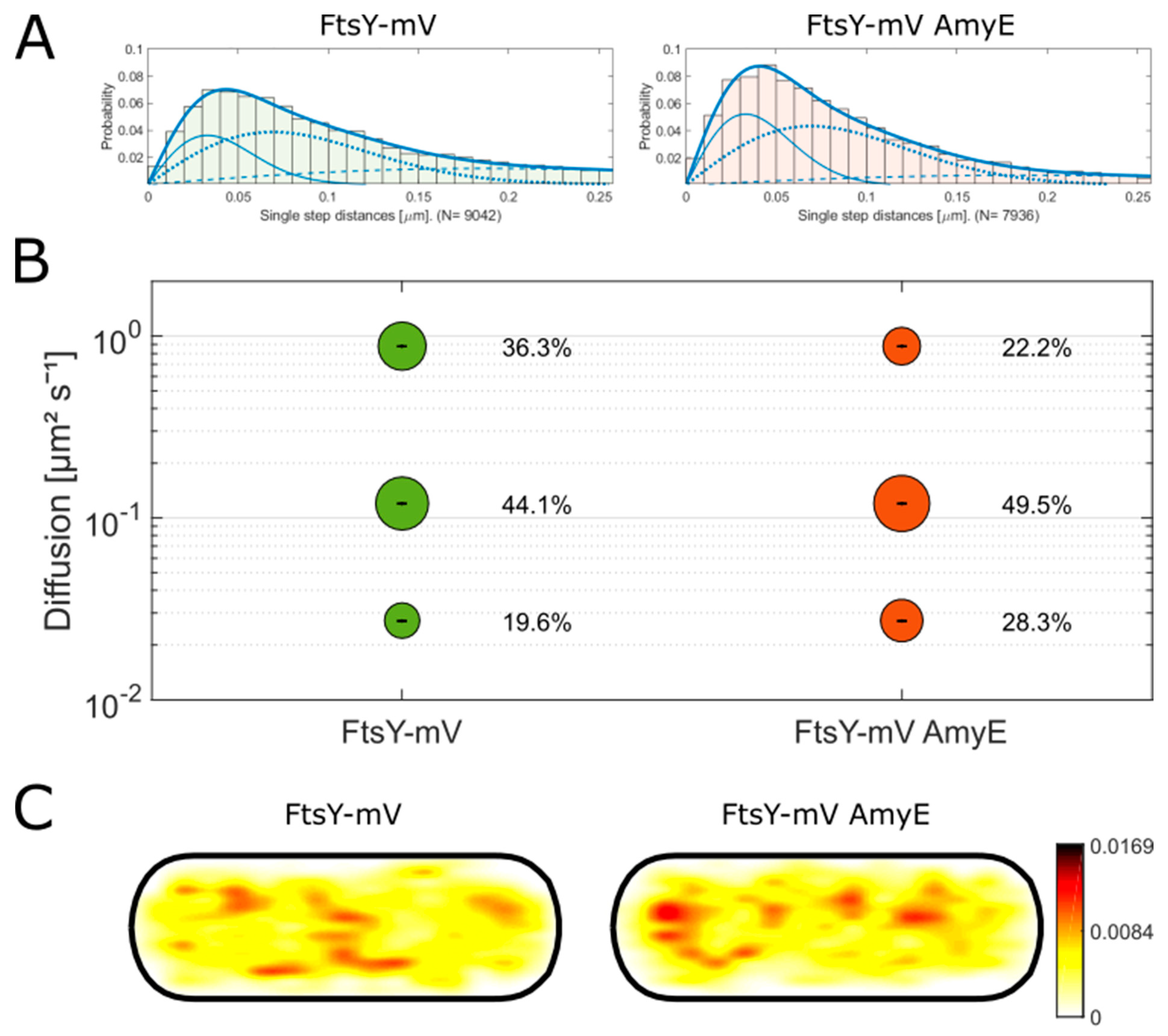B. subtilis Sec and Srp Systems Show Dynamic Adaptations to Different Conditions of Protein Secretion
Abstract
:1. Introduction
2. Methods
2.1. Bacterial Strains and Plasmids
2.2. Growth Conditions and Growth Curves
2.3. Microscopy
2.4. Phadebas Assay
2.5. Western Blot
3. Results
3.1. Seca Single Molecule Dynamics Alter during Transition into Stationary Phase
3.2. The Localization Pattern of Seca Mimics That of Ribosomes
3.3. Seca Single Molecule Dynamics Are Affected by the Overproduction of a Secreted Protein
3.4. Secdf Does Not Show Changes in Single Molecule Dynamics during the Overproduction of Amye
3.5. Ftsy Molecule Dynamics Are Affected by the Overproduction of a Secreted Protein
3.6. Yidc Shows Three Populations Whose Dynamics Are Not Affected by Amye Overproduction
4. Discussion
Supplementary Materials
Author Contributions
Funding
Institutional Review Board Statement
Informed Consent Statement
Data Availability Statement
Acknowledgments
Conflicts of Interest
References
- Green, E.R.; Mecsas, J. Bacterial Secretion Systems: An Overview. Microbiol. Spectr. 2016, 4, 1. [Google Scholar] [CrossRef]
- van Dijl, J.M.; Braun, P.G.; Robinson, C.; Quax, W.J.; Antelmann, H.; Hecker, M.; Müller, J.; Tjalsma, H.; Bron, S.; Jongbloed, J.D.H. Functional genomic analysis of the Bacillus subtilis Tat pathway for protein secretion. J. Biotechnol. 2002, 98, 243–254. [Google Scholar] [CrossRef]
- Koo, B.-M.; Kritikos, G.; Farelli, J.D.; Todor, H.; Tong, K.; Kimsey, H.; Wapinski, I.; Galardini, M.; Cabal, A.; Peters, J.M. Construction and analysis of two genome-scale deletion libraries for Bacillus subtilis. Cell Syst. 2017, 4, 291–305.e297. [Google Scholar] [CrossRef]
- Shanmugam, S.K.; Dalbey, R.E. The Conserved Role of YidC in Membrane Protein Biogenesis. Microbiol. Spectr. 2019, 7. [Google Scholar] [CrossRef]
- Thomaides, H.B.; Davison, E.J.; Burston, L.; Johnson, H.; Brown, D.R.; Hunt, A.C.; Errington, J.; Czaplewski, L. Essential bacterial functions encoded by gene pairs. J. Bacteriol. 2007, 189, 591–602. [Google Scholar] [CrossRef] [PubMed]
- Gouridis, G.; Karamanou, S.; Sardis, M.F.; Schärer, M.A.; Capitani, G.; Economou, A. Quaternary dynamics of the SecA motor drive translocase catalysis. Mol. Cell 2013, 52, 655–666. [Google Scholar] [CrossRef] [PubMed]
- de Keyzer, J.; van der Sluis, E.O.; Spelbrink, R.E.; Nijstad, N.; de Kruijff, B.; Nouwen, N.; van der Does, C.; Driessen, A.J. Covalently dimerized SecA is functional in protein translocation. J. Biol. Chem. 2005, 280, 35255–35260. [Google Scholar] [CrossRef] [PubMed]
- Beckwith, J. The Sec-dependent pathway. Res. Microbiol. 2013, 164, 497–504. [Google Scholar] [CrossRef] [PubMed]
- Ishihama, Y.; Schmidt, T.; Rappsilber, J.; Mann, M.; Hartl, F.U.; Kerner, M.J.; Frishman, D. Protein abundance profiling of the Escherichia coli cytosol. BMC Genom. 2008, 9, 102. [Google Scholar] [CrossRef] [PubMed]
- Schmidt, A.; Kochanowski, K.; Vedelaar, S.; Ahrné, E.; Volkmer, B.; Callipo, L.; Knoops, K.; Bauer, M.; Aebersold, R.; Heinemann, M. The quantitative and condition-dependent Escherichia coli proteome. Nat. Biotechnol. 2016, 34, 104–110. [Google Scholar] [CrossRef] [PubMed]
- Huber, D.; Jamshad, M.; Hanmer, R.; Schibich, D.; Döring, K.; Marcomini, I.; Kramer, G.; Bukau, B. SecA Cotranslationally Interacts with Nascent Substrate Proteins In Vivo. J. Bacteriol. 2017, 199. [Google Scholar] [CrossRef] [PubMed]
- Brundage, L.; Hendrick, J.P.; Schiebel, E.; Driessen, A.J.; Wickner, W. The purified E. coli integral membrane protein SecY/E is sufficient for reconstitution of SecA-dependent precursor protein translocation. Cell 1990, 62, 649–657. [Google Scholar] [CrossRef] [PubMed]
- Drew, D.; Fröderberg, L.; Baars, L.; de Gier, J.-W.L. Assembly and overexpression of membrane proteins in Escherichia coli. Biochim. Biophys. Acta (BBA) Biomembr. 2003, 1610, 3–10. [Google Scholar] [CrossRef]
- Eismann, L.; Fijalkowski, I.; Galmozzi, C.V.; Koubek, J.; Tippmann, F.; Van Damme, P.; Kramer, G. Selective ribosome profiling reveals a role for SecB in the co-translational inner membrane protein biogenesis. Cell Rep. 2022, 41, 111776. [Google Scholar] [CrossRef] [PubMed]
- Seinen, A.-B.; Spakman, D.; van Oijen, A.M.; Driessen, A.J.M. Cellular dynamics of the SecA ATPase at the single molecule level. Sci. Rep. 2021, 11, 1433. [Google Scholar] [CrossRef] [PubMed]
- Shaner, N.C. Fluorescent proteins for quantitative microscopy: Important properties and practical evaluation. Methods Cell Biol. 2014, 123, 95–111. [Google Scholar] [CrossRef] [PubMed]
- Zyprian, E.; Matzura, H. Characterization of signals promoting gene expression on the Staphylococcus aureus plasmid pUB110 and development of a gram-positive expression vector system. DNA 1986, 5, 219–225. [Google Scholar] [CrossRef]
- Paintdakhi, A.; Parry, B.; Campos, M.; Irnov, I.; Elf, J.; Surovtsev, I.; Jacobs-Wagner, C. Oufti: An integrated software package for high-accuracy, high-throughput quantitative microscopy analysis. Mol. Microbiol. 2016, 99, 767–777. [Google Scholar] [CrossRef]
- Jaqaman, K.; Loerke, D.; Mettlen, M.; Kuwata, H.; Grinstein, S.; Schmid, S.L.; Danuser, G. Robust single-particle tracking in live-cell time-lapse sequences. Nat. Methods 2008, 5, 695–702. [Google Scholar] [CrossRef]
- Rösch, T.C.; Altenburger, S.; Oviedo-Bocanegra, L.; Pediaditakis, M.; Najjar, N.E.; Fritz, G.; Graumann, P.L. Single molecule tracking reveals spatio-temporal dynamics of bacterial DNA repair centres. Sci. Rep. 2018, 8, 16450. [Google Scholar] [CrossRef]
- Oviedo-Bocanegra, L.M.; Hinrichs, R.; Rotter, D.A.O.; Dersch, S.; Graumann, P.L. Single molecule/particle tracking analysis program SMTracker 2.0 reveals different dynamics of proteins within the RNA degradosome complex in Bacillus subtilis. Nucleic Acids Res. 2021, 49, e112–e112. [Google Scholar] [CrossRef]
- Jilaveanu, L.B.; Zito, C.R.; Oliver, D. Dimeric SecA is essential for protein translocation. Proc. Natl. Acad. Sci. USA 2005, 102, 7511–7516. [Google Scholar] [CrossRef]
- Strach, M.; Koch, F.; Fiedler, S.; Liebeton, K.; Graumann, P.L. Protein secretion zones during overexpression of amylase within the Gram-positive cell wall. BMC Biol. 2023, 21, 206. [Google Scholar] [CrossRef] [PubMed]
- Stoll, J.; Zegarra, V.; Bange, G.; Graumann, P.L. Single-molecule dynamics suggest that ribosomes assemble at sites of translation in Bacillus subtilis. Front. Microbiol. 2022, 13, 999176. [Google Scholar] [CrossRef] [PubMed]
- Voigt, B.; Antelmann, H.; Albrecht, D.; Ehrenreich, A.; Maurer, K.H.; Evers, S.; Gottschalk, G.; van Dijl, J.M.; Schweder, T.; Hecker, M. Cell physiology and protein secretion of Bacillus licheniformis compared to Bacillus subtilis. J. Mol. Microbiol. Biotechnol. 2009, 16, 53–68. [Google Scholar] [CrossRef] [PubMed]
- Mascarenhas, J.; Weber, M.H.; Graumann, P.L. Specific polar localization of ribosomes in Bacillus subtilis depends on active transcription. EMBO Rep. 2001, 2, 685–689. [Google Scholar] [CrossRef] [PubMed]
- Bakshi, S.; Siryaporn, A.; Goulian, M.; Weisshaar, J.C. Superresolution imaging of ribosomes and RNA polymerase in live Escherichia coli cells. Mol. Microbiol. 2012, 85, 21–38. [Google Scholar] [CrossRef]
- Lewis, P.J.; Thaker, S.D.; Errington, J. Compartmentalization of transcription and translation in Bacillus subtilis. EMBO J. 2000, 19, 710–718. [Google Scholar] [CrossRef]
- Campbell, E.A.; Korzheva, N.; Mustaev, A.; Murakami, K.; Nair, S.; Goldfarb, A.; Darst, S.A. Structural mechanism for rifampicin inhibition of bacterial rna polymerase. Cell 2001, 104, 901–912. [Google Scholar] [CrossRef]
- Dunkle, J.A.; Xiong, L.; Mankin, A.S.; Cate, J.H. Structures of the Escherichia coli ribosome with antibiotics bound near the peptidyl transferase center explain spectra of drug action. Proc. Natl. Acad. Sci. USA 2010, 107, 17152–17157. [Google Scholar] [CrossRef]
- Huber, D.; Rajagopalan, N.; Preissler, S.; Rocco, M.A.; Merz, F.; Kramer, G.; Bukau, B. SecA interacts with ribosomes in order to facilitate posttranslational translocation in bacteria. Mol. Cell 2011, 41, 343–353. [Google Scholar] [CrossRef] [PubMed]
- Yan, S.; Wu, G. Bottleneck in secretion of α-amylase in Bacillus subtilis. Microb. Cell Fact. 2017, 16, 124. [Google Scholar] [CrossRef] [PubMed]
- Priest, F.G. Extracellular enzyme synthesis in the genus Bacillus. Bacteriol. Rev. 1977, 41, 711–753. [Google Scholar] [CrossRef] [PubMed]
- Bolhuis, A.; Broekhuizen, C.P.; Sorokin, A.; van Roosmalen, M.L.; Venema, G.; Bron, S.; Quax, W.J.; van Dijl, J.M. SecDF of Bacillus subtilis, a molecular Siamese twin required for the efficient secretion of proteins. J. Biol. Chem. 1998, 273, 21217–21224. [Google Scholar] [CrossRef] [PubMed]
- Harwood, C.R.; Cranenburgh, R.M. Bacillus protein secretion: An unfolding story. Trends Microbiol. 2008, 16, 73–79. [Google Scholar] [CrossRef] [PubMed]
- Mayer, B.; Schwan, M.; Oviedo-Bocanegra, L.M.; Bange, G.; Thormann, K.M.; Graumann, P.L. Dynamics of Bacterial Signal Recognition Particle at a Single Molecule Level. Front. Microbiol. 2021, 12, 663747. [Google Scholar] [CrossRef] [PubMed]
- Mircheva, M.; Boy, D.; Weiche, B.; Hucke, F.; Graumann, P.; Koch, H.-G. Predominant membrane localization is an essential feature of the bacterial signal recognition particle receptor. BMC Biol. 2009, 7, 76. [Google Scholar] [CrossRef]
- Zhou, Y.; Ueda, T.; Müller, M. Signal recognition particle and SecA cooperate during export of secretory proteins with highly hydrophobic signal sequences. PLoS ONE 2014, 9, e92994. [Google Scholar] [CrossRef]
- Camp, A.H.; Losick, R. A novel pathway of intercellular signalling in Bacillus subtilis involves a protein with similarity to a component of type III secretion channels. Mol. Microbiol. 2008, 69, 402–417. [Google Scholar] [CrossRef]
- Chiba, S.; Ito, K. MifM monitors total YidC activities of Bacillus subtilis, including that of YidC2, the target of regulation. J. Bacteriol. 2015, 197, 99–107. [Google Scholar] [CrossRef]
- Kumazaki, K.; Chiba, S.; Takemoto, M.; Furukawa, A.; Nishiyama, K.-I.; Sugano, Y.; Mori, T.; Dohmae, N.; Hirata, K.; Nakada-Nakura, Y.; et al. Structural basis of Sec-independent membrane protein insertion by YidC. Nature 2014, 509, 516–520. [Google Scholar] [CrossRef] [PubMed]
- van der Sluis, E.O.; Driessen, A.J. Stepwise evolution of the Sec machinery in Proteobacteria. Trends Microbiol. 2006, 14, 105–108. [Google Scholar] [CrossRef] [PubMed]
- Halic, M.; Gartmann, M.; Schlenker, O.; Mielke, T.; Pool, M.R.; Sinning, I.; Beckmann, R. Signal Recognition Particle Receptor Exposes the Ribosomal Translocon Binding Site. Science 2006, 312, 745–747. [Google Scholar] [CrossRef] [PubMed]
- Nicolas, P.; Mäder, U.; Dervyn, E.; Rochat, T.; Leduc, A.; Pigeonneau, N.; Bidnenko, E.; Marchadier, E.; Hoebeke, M.; Aymerich, S.; et al. Condition-dependent transcriptome reveals high-level regulatory architecture in Bacillus subtilis. Science 2012, 335, 1103–1106. [Google Scholar] [CrossRef] [PubMed]
- Neef, J.; van Dijl, J.M.; Buist, G. Recombinant protein secretion by Bacillus subtilis and Lactococcus lactis: Pathways, applications, and innovation potential. Essays Biochem. 2021, 65, 187–195. [Google Scholar] [CrossRef]
- Oswald, J.; Njenga, R.; Natriashvili, A.; Sarmah, P.; Koch, H.-G. The Dynamic SecYEG Translocon. Front. Mol. Biosci. 2021, 8. [Google Scholar] [CrossRef]
- Jomaa, A.; Boehringer, D.; Leibundgut, M.; Ban, N. Structures of the E. coli translating ribosome with SRP and its receptor and with the translocon. Nat. Commun. 2016, 7, 10471. [Google Scholar] [CrossRef]






Disclaimer/Publisher’s Note: The statements, opinions and data contained in all publications are solely those of the individual author(s) and contributor(s) and not of MDPI and/or the editor(s). MDPI and/or the editor(s) disclaim responsibility for any injury to people or property resulting from any ideas, methods, instructions or products referred to in the content. |
© 2024 by the authors. Licensee MDPI, Basel, Switzerland. This article is an open access article distributed under the terms and conditions of the Creative Commons Attribution (CC BY) license (https://creativecommons.org/licenses/by/4.0/).
Share and Cite
Fiedler, S.M.; Graumann, P.L. B. subtilis Sec and Srp Systems Show Dynamic Adaptations to Different Conditions of Protein Secretion. Cells 2024, 13, 377. https://doi.org/10.3390/cells13050377
Fiedler SM, Graumann PL. B. subtilis Sec and Srp Systems Show Dynamic Adaptations to Different Conditions of Protein Secretion. Cells. 2024; 13(5):377. https://doi.org/10.3390/cells13050377
Chicago/Turabian StyleFiedler, Svenja M., and Peter L. Graumann. 2024. "B. subtilis Sec and Srp Systems Show Dynamic Adaptations to Different Conditions of Protein Secretion" Cells 13, no. 5: 377. https://doi.org/10.3390/cells13050377
APA StyleFiedler, S. M., & Graumann, P. L. (2024). B. subtilis Sec and Srp Systems Show Dynamic Adaptations to Different Conditions of Protein Secretion. Cells, 13(5), 377. https://doi.org/10.3390/cells13050377





